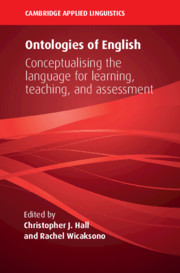Book contents
- Ontologies of English
- The Cambridge Applied Linguistics Series
- Ontologies of English
- Copyright page
- Dedication
- Contents
- Figures
- Tables
- Contributors
- Series Editors’ Preface
- Acknowledgements
- Transcription Conventions
- Part I Introduction
- Part II English in/for L2 Learning and Teaching
- 3 English in the Real World
- 4 From Constructions to Social Action
- 5 Native and Non-native Speakers of English in TESOL
- Part III English in Schools
- Part IV Assessing English
- Part V English in Lingua Franca Contexts
- Part VI English and Social Practice
- Part VII Commentary and Conclusions
- Index
- References
5 - Native and Non-native Speakers of English in TESOL
from Part II - English in/for L2 Learning and Teaching
Published online by Cambridge University Press: 24 December 2019
- Ontologies of English
- The Cambridge Applied Linguistics Series
- Ontologies of English
- Copyright page
- Dedication
- Contents
- Figures
- Tables
- Contributors
- Series Editors’ Preface
- Acknowledgements
- Transcription Conventions
- Part I Introduction
- Part II English in/for L2 Learning and Teaching
- 3 English in the Real World
- 4 From Constructions to Social Action
- 5 Native and Non-native Speakers of English in TESOL
- Part III English in Schools
- Part IV Assessing English
- Part V English in Lingua Franca Contexts
- Part VI English and Social Practice
- Part VII Commentary and Conclusions
- Index
- References
Summary
This chapter explores ideas about ‘(non-)native’ speakers of English, with particular reference to the professional context of teaching English to speakers of other languages (TESOL). The use of ‘(non-)native’ speaker to describe a person’s use of English remains common in a variety of domains, despite much scholarly and professional argument against the term. Given that learners and teachers comprise the educational context of this chapter, I have chosen to focus on the native and non-native speakers themselves, rather than on their (so-called) native and non-native uses of English. In doing so, I hope not to fall into the trap of thinking of people as permanent members of closed categories, but, on the contrary, show how we might raise awareness of the (potentially negative) effects of such thinking on speakers of English, in the TESOL profession.
Keywords
- Type
- Chapter
- Information
- Ontologies of EnglishConceptualising the Language for Learning, Teaching, and Assessment, pp. 80 - 98Publisher: Cambridge University PressPrint publication year: 2020
References
- 1
- Cited by

